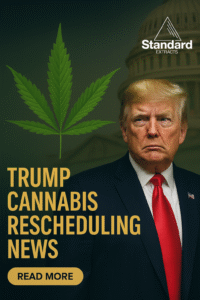California’s 19% Cannabis Excise Tax: Is the Golden State Pricing Out Its Own Market?
Table of contents
- 1. Why Did California Raise the Excise Tax?
- 2. The Legislative Backstory: From Cultivation Tax to AB 564
- 3. Sticker Shock: How the 19% Rate Hits Consumers
- 4. The Supply-Side Squeeze on Growers & Dispensaries
- 5. Legal vs. Black Market: Who Wins This Tug-of-War?
- 6. A Smarter Path Forward—Plus High-Compliance Alternatives
- 🎯 Final Thoughts + Call to Action
1. Why Did California Raise the Excise Tax?
On July 1, 2025, California officially bumped its cannabis excise tax from 15% to 19%. The change rippled across dispensary menus overnight. Shoppers woke up to higher totals at checkout, even before local sales taxes piled on. For many, the price jump felt sudden—but policymakers insist it was years in the making.

“The goal was to keep funding youth programs after removing the cultivation tax,” explains Dale Gieringer, director of California NORML. “Unfortunately, higher excise fees can backfire if they push buyers underground.”
Quick Facts
- New Rate: 19% statewide excise tax on all retail cannabis sales.
- Effective Date: July 1, 2025.
- Reason: Replace lost revenue after the cultivation tax was scrapped in 2022.
- Current Proposal: Assembly Bill 564 aims to dial the excise rate back to 15% by 2026.
For context, California already levies one of the nation’s steepest legal-weed tax stacks. Add state sales tax (7.25% on average) and local cannabis business taxes (up to 15% in some counties), and the consumer burden can top 40%.
Did you know?
In 2024, the median price for an eighth-ounce in California’s legal market was $35. With the new excise rate, that same eighth could easily hover near $42–$44 before local fees.
As prices climb, so does pressure on the sober-curious generation and cost-sensitive consumers. Some may pivot to hemp-derived alternatives, like StandardCBD’s legal Delta-8 options, which remain taxed as regular retail goods—not sin taxes—under federal law.
Early sales data hint at turbulence ahead. During the first week of July, several Bay-Area dispensaries reported a 5–8% drop in foot traffic versus late June. Analysts fear a longer-term slide if prices stay elevated without wage growth to match.
Still, state officials argue the move safeguards billions in annual public-health funding. Whether that trade-off proves sustainable will depend on how the next five sections unfold—especially the fate of AB 564.
2. The Legislative Backstory: From Cultivation Tax to AB 564
To understand why California lawmakers approved the 19% cannabis excise tax, we need to rewind to 2022, when they eliminated the unpopular cultivation tax. That move was meant to ease pressure on small growers struggling with razor-thin margins and excessive regulation. But there was a catch: the revenue lost from cutting cultivation taxes had to be made up elsewhere.
Enter the excise tax increase.
This shift was part of a broader restructuring deal. Legislators saw the cultivation tax—once pegged to the weight of raw flower—as unfair, especially as prices dropped. Growers were paying the same rate whether they sold top-shelf buds or trim. By shifting the burden downstream to consumers, the state aimed for a simpler, more consistent revenue stream.
Timeline of Key Policy Changes
| Year | Policy Change | Impact |
|---|---|---|
| 2022 | Eliminated cultivation tax | Relieved growers, slashed one revenue stream |
| 2023 | Planned excise tax hike announced | Set the stage for consumer-facing price increase |
| July 1, 2025 | Excise tax raised from 15% to 19% | Consumers bear brunt of tax increase |
| Pending | AB 564 | Could reduce excise tax back to 15% by 2026 |
Assembly Bill 564, still under consideration, aims to stabilize California’s legal cannabis industry by capping excise tax rates and encouraging compliance. The bill has earned support from trade groups, retailers, and advocacy organizations like NORML and Americans for Safe Access.
If passed, it could slow or reverse the market erosion that many insiders fear is already underway.
Quote from a Public Figure:
“Without meaningful tax relief, we’re going to lose the legal cannabis market in California.”
— Jerred Kiloh, President, United Cannabis Business Association
Whether that warning becomes reality hinges on how the industry—and consumers—respond in the coming months. Next, we’ll look at how this tax increase is hitting everyday buyers and medical patients where it hurts most: their wallets.
3. Sticker Shock: How the 19% Rate Hits Consumers
For California cannabis consumers, the jump from a 15% to a 19% excise taxisn’t just numbers—it’s felt directly at the register. And with inflation already biting into household budgets, this added expense could push more shoppers back into the unregulated market.
Consider this example: A pre-tax purchase of $100 worth of cannabis now incurs $19 in excise tax, up from $15. Add state and local sales taxes, and the final bill could total $130 or more. Multiply that over a few trips per month, and the cost difference becomes significant.
Price Comparison: Before vs. After July 1, 2025
| Product | Pre-Tax Price | Old Total (15% Tax) | New Total (19% Tax) |
|---|---|---|---|
| 1/8th Flower | $35 | $40.25 | $41.65 |
| Vape Cartridge | $50 | $57.50 | $59.50 |
| Edible Pack | $30 | $34.50 | $35.70 |
That extra few dollars per item may not seem dramatic on its own, but over time, it leads to consumer fatigue—especially for medical users, veterans, and low-income communities who rely on plant medicine for pain, anxiety, or sleep.
Notably, these changes don’t impact hemp-derived or federally legal cannabinoids like Delta-8 and THC-P gummies from StandardCBD. These remain outside California’s cannabis excise tax scope, offering a tax-friendly alternative for budget-conscious shoppers.
Ways Consumers Are Coping
- Bulk buying to reduce per-visit tax pain
- Switching to functional mushroom gummies and Amanita chocolates
- Turning to the illicit market despite risks
- Exploring mail-order legal hemp options from StandardCBD.com
Customer Tip: Use discount codes like THANKYOU20 on StandardCBD to save 20%—more than offsetting California’s new excise hike.
Whether it’s edibles, vapes, or pre-rolls, the sticker shock is real—and it’s driving a wedge between intention and action. Even loyal legal-market customers may rethink their next purchase.
Up next: we’ll dive deeper into how this tax spike affects dispensaries, growers, and manufacturers already battling tight margins and red tape.
4. The Supply-Side Squeeze on Growers & Dispensaries
While consumers feel the pinch at the register, the cannabis tax hike is also squeezing California’s already embattled licensed growers, brands, and dispensaries. Many are operating on slim margins, and the 19% excise tax—though collected at retail—ripples up the supply chain in the form of decreased demand, thinner profits, and tighter cash flow.
The problem? California’s cannabis market was already oversupplied and overregulated. This new tax hike doesn’t just strain shoppers—it threatens to sink licensed operators who’ve barely survived the last few years.
The Harsh Economic Reality
- Over 40% of cannabis operators in California are operating at a net loss (2024 BDSA data).
- State and local taxes + compliance fees eat up 35–50% of total revenuefor many retailers.
- Since 2019, over 2,000 licensed growers have exited the California market.
Dispensaries are particularly vulnerable. With fewer people buying or purchasing smaller amounts, average cart values drop. And for shops locked into expensive long-term leases, labor costs, and security mandates, there’s little room to maneuver.
Small-batch cultivators and craft producers—who were once touted as the heart of California cannabis—now find themselves fighting for shelf space amid distributor consolidation and price wars. And for vertically integrated brands, the tax increases at retail can’t be absorbed at scale.
Quote from Industry
“We’re not asking for a handout. We’re asking for a level playing field where the legal market can survive.”
— Amber Senter, CEO of MAKR House and equity advocate
In contrast, hemp-derived cannabinoid businesses like StandardCBD are thriving under a different model. These brands operate under USDA and FDA compliance, avoiding California’s burdensome cannabis licensing requirements—and taxes. Products like our Amanita mushroom chocolate bar or THC-P gummies can legally ship to most states and provide consumers with quality experiences without a tax-driven markup.
What Some Retailers Are Doing to Stay Afloat
- Relying more on live cannabis-derived terpenes to differentiate flavor and effects
- Introducing hemp-based SKUs that bypass excise taxes
- Offering promotions tied to untaxed holiday weekends
- Cutting staff and trimming product offerings to preserve liquidity
The supply chain is under unprecedented pressure. Unless AB 564 or a similar reform is passed soon, many small players may not last through year-end.
Up next: we’ll break down the implications for the illicit market and ask the uncomfortable question—is California helping the black market thrive?

5. Legal vs. Black Market: Who Wins This Tug-of-War?
With California’s cannabis excise tax now at 19%, many consumers are doing the math—and finding that the illegal market offers more for less. It’s an uncomfortable truth: while the state tightens its grip on legal operators, the unlicensed market continues to thrive, largely untaxed and unregulated.
Despite legalization in 2016, California’s illegal cannabis market still accounts for 60% to 70% of all cannabis sales statewide (New Frontier Data, 2024). And with the recent tax hike, that percentage may climb even higher.
Side-by-Side Comparison: Legal vs. Illicit Cannabis
| Factor | Legal Market | Illegal Market |
|---|---|---|
| Product Testing | Required by law | Not required; often absent |
| Taxes | 19% excise + 7–15% local | None |
| Price (1/8th flower) | $42–$50 (with tax) | $25–$30 (no tax) |
| Product Availability | Limited to licensed SKUs | Often broader, including banned SKUs |
| Safety Assurance | Certified, lab-tested | Risk of contaminants, mislabeling |
Though the legal market offers peace of mind, consistent potency, and product transparency, many price-sensitive consumers still opt for unlicensed sellers—especially those in delivery-only zones or cities that ban legal retail storefronts.
And it’s not just consumers. Legacy growers in regions like Humboldt and Trinity—who’ve faced license delays, land-use battles, and razor-thin margins—are quietly returning to the underground market to survive.
Quote from the Ground
“We tried to play by the rules. But with taxes this high, it’s like the state wants us to fail.”
— Anonymous licensed grower, Emerald Triangle
Meanwhile, StandardCBD.com continues to serve both California and national customers with fully legal, compliant, and lab-tested options that remain outside the cannabis tax system. Our Delta-8 and THC-P edibles deliver euphoric effects similar to cannabis—but with no cannabis tax markup or regulatory headaches.
Popular Legal Alternatives to Taxed Cannabis
- Amanita mushroom chocolate bar – a functional and legal psychedelic treat
- Delta-8 + THC-P gummies – euphoric, smooth, and fully legal
- Terpene-infused cannabis beverages – hemp-based refreshment without the red tape
Until the state brings down tax rates—or ramps up enforcement of the illicit market—the tug-of-war will continue. And the illegal side, for now, is winning.
In our final section, we’ll explore possible solutions and how companies like StandardCBD are helping customers and retailers stay compliant without breaking the bank.

6. A Smarter Path Forward—Plus High-Compliance Alternatives
As the dust settles on California’s 19% cannabis excise tax, one thing is clear: the current system is unsustainable for both businesses and consumers. But there is a path forward—one that balances revenue generation with market survival and consumer access.
Industry leaders, economists, and lawmakers are rallying behind Assembly Bill 564, which proposes to restore the excise tax back to 15% by 2026. If passed, it could offer crucial relief while the market stabilizes. But legislation takes time—and the cannabis economy needs near-term solutions.
What Needs to Change
- Tax Restructuring: Incentivize legal purchases by lowering rates and standardizing local taxes.
- Expanded Access: Encourage more cities to allow legal dispensaries to reduce the demand for illicit products.
- Small Business Support: Provide tax credits or subsidies to compliant microbusinesses and equity applicants.
- Consumer Education: Inform the public about the risks of black-market products and the benefits of tested alternatives.
While Sacramento debates solutions, StandardCBD continues to innovate by offering federally legal, tax-free alternatives that meet consumer needs today—not two years from now. Our products are shipped nationwide, lab-tested, and formulated for wellness, relief, and euphoria—without the cannabis tax baggage.
Why StandardCBD Works for Californians (and Everyone Else)
| Product Category | Effect | Why It’s Better |
|---|---|---|
| Delta-8 + THC-P Gummies | Relaxing, euphoric, legal high | No cannabis excise tax; ships nationwide |
| Amanita Mushroom Chocolate Bar | Dreamy, psychedelic, calming | Not scheduled; functional and innovative |
| Live Terpenes | Flavored enhancement, entourage effect | Customizable for beverages or vape blends |
Instead of punishing consumers with higher taxes, our goal is to empower them with better choices. Whether you’re avoiding sticker shock or exploring sober-curious alternatives, we’ve built a product ecosystem that reflects quality, compliance, and affordability.
“The future of cannabis isn’t just legalization—it’s accessibility, affordability, and innovation.”
— Taher Afghani, Founder of StandardCBD
🎯 Final Thoughts + Call to Action
The July 1st tax hike is a wake-up call for the California cannabis industry. But it’s also an opportunity to rethink the system—and reconnect consumers with safe, accessible, and tax-efficient products.
StandardCBD.com is here to help you navigate that shift. Whether you’re looking for THC-P gummies, Amanita mushroom chocolates, or federally legal Delta-8 blends—we’ve got options that work for your body and your budget.
🛒 Ready to Shop Smarter?
Shop now and use code THANKYOU20 for 20% off your entire order.Explore Our Legal Alternatives
Don’t let California’s tax hike limit your choices. Choose a brand that puts your well-being—and your wallet—first.




